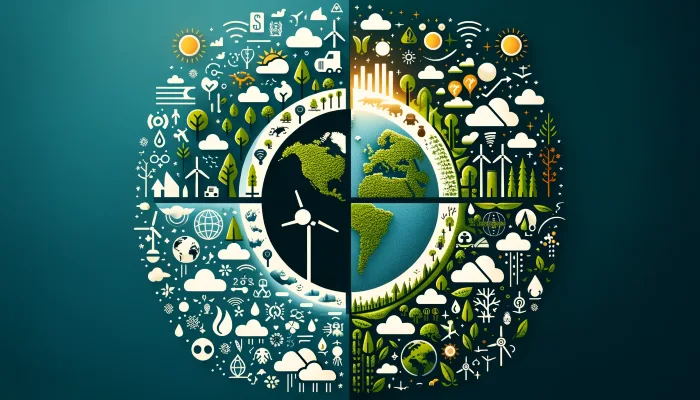From alternative energy sources to disappearing worms, these emerging trends could significantly reshape the natural world around us. Here’s what we think you should be aware of so far this year:
15 Critical Biodiversity Challenges of 2024: In Brief
1. Hydrogen: Climate Solution or New Problem?
Hydrogen fuel production is gaining popularity, but the methods matter. Hydrogen derived from natural gas still relies on fossil fuels, while using water as a source could disrupt habitats. Scientists must develop safe and sustainable ways to scale up hydrogen production.
2. Ammonia's Impact: Fertilizer Boom & Environmental Consequences
New techniques make ammonia fertilizer cheaper to produce, reducing its climate footprint. However, this risks increased use, leading to more air and water pollution. Plus, fertilizer production increases nitrous oxide gas release, another powerful greenhouse gas.
3. Hungry Microbes: The Future of Food?
This trend is truly sci-fi! Bacteria fed on hydrogen, nitrogen, and carbon dioxide create a high-protein food source – potentially slashing climate impacts compared to traditional agriculture. If energy inputs are renewable, this could be a breakthrough in sustainable food production.
4. Plants Thriving in the Dark
Using electricity and carbon dioxide to produce acetate (a compound usually made by photosynthesis) could allow crops to grow even without sunlight. Maximizing yield in indoor environments, if sustainably powered, could lessen our reliance on outdoor farms, protecting natural habitats.
5. Rock Dust Debate: Benefits and Risks for Soil and Sea
Spreading carbon-storing rock dust on farms may combat climate change and boost crops. But it could negatively impact water quality, increase heavy metal pollution, and harm soil organisms. The potential rewards and ecological dangers need careful weighing.
6. Earthworms in Crisis: Why a Healthy Underground Matters
We often forget about these unseen heroes! Earthworms enrich soil and recycle nutrients, vital for farming and ecosystems. Pesticide use seems to be slashing earthworm populations, potentially endangering our food sources and long-term environmental health.
7. "Listening" to Soil: Tech Innovations for Healthy Ecosystems
Instead of invasive digging, sound devices capture underground worm and bug activity, revealing a soil’s health. Easy monitoring lets us track and restore damaged soils, which support thriving biodiversity.
8. Smoke is the New Climate Threat
More frequent, intense wildfires add alarming amounts of smoke to the atmosphere. Smoke blocks sunlight, disrupts rain patterns, and alters global climate cycles, upsetting fragile ecosystems and affecting the well-being of many species, including humans.
9. Printable DNA: Pandora's Box for Conservation
Creating custom DNA strands is becoming easier. We could design organisms resistant to climate change, diseases, and pests, reducing land clearing and pesticide use. But risks remain: engineered organisms could outcompete native species and damage ecological balance.
10. Predicting Toxicity: Less Damage through Better Science
Instead of using trial-and-error to see if a chemical is harmful, scientists aim to accurately predict a chemical’s negative effects based on its structure. This can help create new products that offer benefits without ecological and health risks.
11. Bird-Bashing Towers: Megacities vs. Migration
Huge, reflective skyscrapers with wind turbines in Saudi Arabia threaten migrating birds flying from Europe to Africa. With no environmental studies done, we risk mass bird deaths, disrupting ecosystems at both ends of their incredible journey.
12. Sea Urchin Crisis: Coral Reefs at Risk
Mass die-offs in the Caribbean, Mediterranean, and possibly Red Sea devastate corals. Urchins eat algae that otherwise overwhelm reefs. If scientists identify a disease culprit, other marine ecosystems facing similar threats could be in danger.
13. Ocean Carbon-Sponge: Promise & Uncertainty
With their incredible ability to absorb carbon dioxide, oceans are viewed as potential climate saviors. Some propose adding fertilizer, algae farming, and artificial CO2 injection. Careful evaluation is needed, as untested methods have significant downsides for marine life and even human societies.
14. Trouble in the Twilight Zone
This deep ocean layer (200 to 1000 meters below the surface) is rich in life and is a carbon storage champion. However, as waters warm, this carbon absorption power and ability to support rich marine life may diminish.
More To Discover
- The Push to Grant Nature Legal Rights Just Took A Huge Step Forward In Panama
- The Required Innovations in Food and Agriculture for Climate Resilience and To Feed The Future of The World
- How Our Salt Footprint Is Threatening Global Ecosystems And What We Can Do About It
- Combatting Microplastic Pollution: How You Can Make Your Laundry Routine More Sustainable
15. Changing Ocean Currents: Hidden, Widespread Risks
Human-caused climate change is disrupting underwater currents, altering oxygen levels, impacting food chains, and affecting life on land. Unpredictable effects from shifting winds and altered salinity mean scientists face a massive and urgent puzzle to solve.
In 2024, innovation with a conscience is key – protecting biodiversity demands proactive solutions and careful consideration of long-term consequences. The reality is that 2024 presents no easy answers for conserving biodiversity. These issues show that potential solutions often carry their own ecological price tags.



















